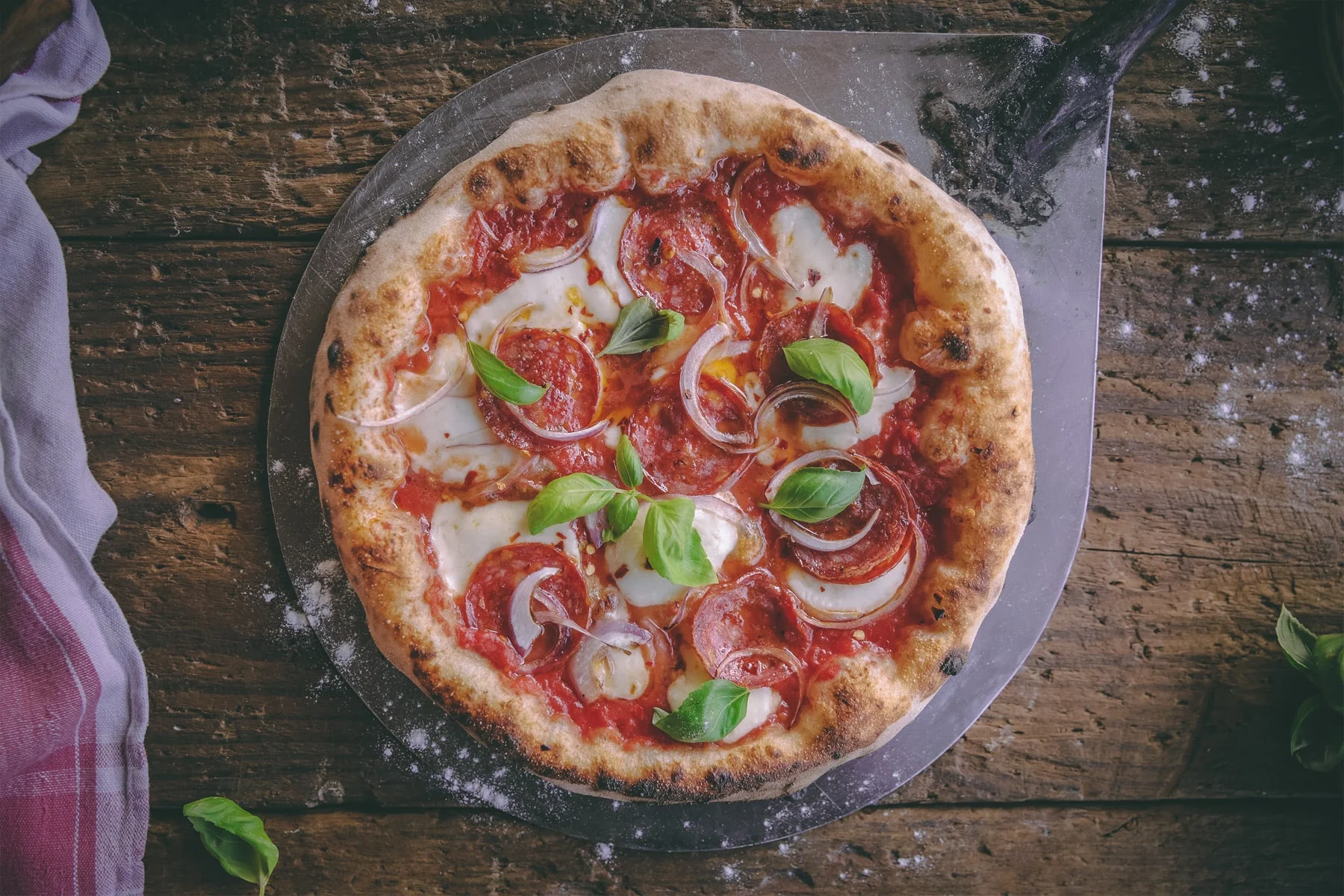How to Control the Temperature of a Wood-Fired Pizza Oven

Baking a homemade pie in a wood-fired outdoor pizza oven is a memorable, hands-on experience. Wood is an excellent fuel source known for its ability to create high heat. But it can take a little practice to get just right. Here’s how you can get a handle on controlling pizza oven temperature.
What Is the Best Fuel for a Wood-Fired Pizza Oven?

No, this isn’t a trick question! Wood is, of course, the best fuel for a wood-fired pizza oven, and any hardwood will work. But you should always use kiln-dried wood for pizza ovens.
Kiln-dried wood has a lower moisture content, which means it burns hotter, cleaner, and with less smoke. It also burns more consistently (learn more about how moisture content and wood density affect the burn rate of wood in this video).
Some of the best wood-fired pizza oven fuel choices include oak and maple—both excellent hardwoods that burn slowly and evenly, making them ideal for maintaining high temperatures.
Whichever hardwood you choose, it’s best to source locally procured kiln-dried products to minimize the risk of introducing pests or disease from outside your region or purchasing kiln-dried wood from a trusted supplier, like Fontana Forni.
When working with kiln-dried wood, simply add a small piece of firewood every 15-20 minutes to keep the fire going. Use an infrared thermometer to monitor the internal oven and pizza stone temperature.
Avoid:
- Wood pellets: While pellets might work in some grills and pellet stoves, they simply don’t provide the sustained, high-heat burn needed for a proper wood-fired pizza oven. Stick with kiln-dried wood to keep your fire burning consistently and your pizzas cooking to perfection.
- High-resin softwoods: This includes wood species like pine and birch. While these woods burn quickly, they produce a lot of smoke and soot, which you don’t want for cooking.
Here is a step-by-step guide to cooking up a perfect pizza.
1: Fire Up Your Oven
It all starts with a well-built fire. Start small with kindling. Use softer wood at the beginning, then add more wood as it starts to catch. Open the damper and oven door for around 5-10 minutes to allow proper airflow. More oxygen means a better-burning fire.
After an initial smoking period, the fire should catch, and the oven should begin to warm. At this point, partially close the chimney damper to let smoke escape, and crack the door slightly to allow in more oxygen, if needed.
The door has perforations to allow the fire to breathe, so this may not be necessary if your fire is well-oxygenated. You may need to add more wood—or even more kindling—to ensure that your fire doesn’t snuff out before it can stabilize.
2: Allow the Dome to Heat Through
Getting the temperature of a wood-fired pizza oven right is everything. Fontana Forni ovens distribute heat through radiant heat, convection, and conduction for the perfect bake. The fire heats the dome, radiating heat downward while circulating hot air for even cooking. Meanwhile, the stone floor conducts heat to the crust.
This evenly distributed radiant heat melts the cheese and cooks the toppings through. As your pizza cooks, you’ll need to carefully monitor your fire and make sure you add fuel at a reasonable rate, neither starving it nor building it up too far.
3: Monitor Temperature Carefully

To get your oven up to the right temperature, it is important to note the distinction between chamber temperature and oven floor temperature. Because heat rises, the chamber usually reaches the desired temperature before the stone floor heats.
Generally, a good floor temperature for wood-fired pizza ovens is as follows:
- 750° F with our standard stones (cook time = 2-2.5 minutes)
- 850 - 900° F with our Saputo stones (cook time = 90 seconds)
We use a digital infrared thermometer to accurately measure the stone temperature. This is critical for achieving consistent results in baking the pizza.
If the stones aren’t hot enough, the top of the pizza will burn before the dough underneath can fully cook. Do not start cooking until your oven and stone temperature are as close to equal as possible. Measure the heat of your stone with an infrared thermometer to be sure it’s the right temperature.
Use the chimney damper and the oven door to help regulate the temperature. Open the damper to reduce interior temperature, if needed. When you achieve the right temperature, close the damper about halfway to help retain heat. Open the door slightly, as needed, to oxygenate the fire.
To recap:
- Start with the right wood. Kiln-dried hardwoods like oak and maple work best. Avoid wood pellets, which don’t provide enough/consistent heat.
- Prepare the pizza oven. Make sure the door of your outdoor wood-fired pizza oven is left slightly open and the chimney damper is set to completely open so your fire can get sufficient oxygen. Partially close the damper after the fire starts to let smoke ventilate while preserving heat.
- Let the dome heat through. This will ensure that there is enough radiant heat to cook your pizza to perfection.
- Monitor temperature carefully as your pizza bakes. Use an infrared thermometer to test the temperature of the oven itself and the pizza stone. Make sure the oven and the stone are at the right temperature before placing your pizza in the oven.
Now that you have the basics of wood-fired pizza oven temperature control down, it’s time to get cooking!

Cook Like a Professional with the Best Wood-Fired Pizza Ovens on the Market
If you consider yourself a food connoisseur, baking your own pizza in a wood oven is a must-add to your bucket list. With an authentic, professional-grade wood-fired pizza oven from Fontana Forni, you can bring the traditional goodness of Italian brick pizza ovens right to your backyard.
Browse our ovens online or call us at (877) 842-9822 for more information.



